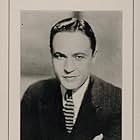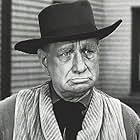Aggiungi una trama nella tua lingua"The Heart of Maryland" (1927) is a silent costume Vitaphone drama produced and distributed by Warner Bros. and directed by Lloyd Bacon. The film stars Dolores Costello in the title characte... Leggi tutto"The Heart of Maryland" (1927) is a silent costume Vitaphone drama produced and distributed by Warner Bros. and directed by Lloyd Bacon. The film stars Dolores Costello in the title character and features Jason Robards, Sr."The Heart of Maryland" (1927) is a silent costume Vitaphone drama produced and distributed by Warner Bros. and directed by Lloyd Bacon. The film stars Dolores Costello in the title character and features Jason Robards, Sr.
Foto
Jason Robards Sr.
- Maj. Alan Kendrick
- (as Jason Robards)
Trama
Lo sapevi?
- QuizThe Library of Congress has 6 of 7 reels, the third reel is currently missing. Warner Bros. doesn't have a plan to release "The Heart of Maryland" if the film would have the 3rd reel.
- ConnessioniVersion of Barriera di sangue (1915)
Recensione in evidenza
The title of this Civil War melodrama has two meanings. 'The Heart of Maryland' suggests that its heroine embodies the heart and soul of her native state Maryland. But her name is Maryland Calvert, so the title also refers to the heart (or mettle) of this story's heroine.
The nitrate print which I viewed was somewhat deteriorated, yet (so far as I could tell) was complete, with no footage missing. Still, there seemed to be several gaps in the narrative. This sort of Swiss-cheese storytelling was commonplace in movies of the silent era, as they were often filmed without a script, with intertitles written afterwards to paper over any cracks in the narrative. But 'The Heart of Maryland' is based on a stage play, so I assume that there was a plot line in place before this movie was shot. Yet this story 'jumps' several times, with characters abruptly changing motivations and performing actions that have no foreshadowing.
'The Heart of Maryland' takes place in that state during the American Civil War, but -- as far as I can tell -- this movie is entirely fiction, and does not depict actual events. To my intense annoyance, this movie follows the same political line as 'Birth of a Nation', 'Gone with the Wind' and 'The General' (the last a brilliant movie which is politically contemptible). The heroine Maryland Calvert uncritically accepts that the Confederacy is a noble cause, and that the Union forces are villainous interlopers. There is, of course, absolutely no mention of slavery. We see some black plantation workers in this movie, but apparently they're just pitching in and helping the white folks.
CONTAINS SPOILERS. Southern belle Maryland Calvert is the unwilling recipient of the affections of hayseed Tom Boone. She makes it clear to Boone that the path to her heart leads through the Confederate army's recruiting office. (Turn left at the shoo-fly pie.) Maryland is more interested in handsome Alan Kendrick, yet he has gone over to the Union cause. Then he gets captured. Then he gets tortured. Apparently a couple of characters in this southern-fried sour mash are spies, or else they changed sides. I couldn't be sure, because several stretches of the film were too deteriorated to risk running through my Steenbeck viewer.
The local church has been commandeered for use as a military prison. (I found this part quite believable.) Captain Thorpe is on the Confederate side, but he's clearly a baddie even though this film depicts the Yankees as the villains. (See how confusing it gets?) Kendrick is brought to Thorpe, bound and helpless. Thorpe has got drunk on whatever Confederate officers drank (mint juleps, I guess), and he proceeds to abuse Maryland (the woman, not the state) in front of his hog-tied prisoner while Kendrick strains manfully at his bonds. Finally, Maryland grabs a bayonet and stabs Thorpe, then unties Kendrick. He puts on Thorpe's military coat, which is identified as 'gray' (American spelling) in the intertitles. That's another thing Civil War movies always get wrong: most of the divisions in the Confederate army wore *brown* uniforms -- butternut brown, to be precise -- yet we're forever hearing about 'the blue and the grey'. Only a few Confederate divisions wore grey. Anyhow, Kendrick escapes from behind Confederate lines wearing Thorpe's grey coat, heading for the Union garrison at Charlesville.
The wounded Thorpe angrily gives the order to attack the Charlesville garrison. But the rebel forces are already in the field: how will they get the order to attack? Thorpe tells Eli Stanton, the deaf old sexton, to ring the church bell ... signalling the rebel forces to attack. Maryland, previously a loyal southerner, now decides to save the Union forces at Charlesville. She rushes up into the bell tower and flings herself onto the clapper, clinging fast so that it can't strike. There's plenty of flinging and clinging but no ringing. The sexton, conveniently deaf (so he can't hear the bell NOT ringing), is too senile to notice that there's more weight than usual on the bell rope.
'The Heart of Maryland' was filmed three times in the silent era (actor Warner Richmond appearing in two versions), yet -- so far as I know -- it was never remade in the sound-movie era. What little credibility this story possesses would be lost if this film had a soundtrack. In a talkie, we would hear the gasps and moans of Maryland as she clings to the bell. We would also realise that her attempts to muffle it aren't very successful. More importantly, Thorpe and his men in the church prison would notice that the bell isn't tolling properly ... because they aren't hearing what they expected to hear. Since this is a silent film, and nobody would hear the bell whether it rings or not, none of those questions arise. Worse luck, the climactic event in this movie is stolen from a popular Victorian poem: 'Curfew Must Not Ring Tonight' by Rose Hartwick Thorpe. (Hmm, same surname as this movie's villain.)
Dolores Costello is pretty but not otherwise impressive as the southern belle on the southern bell who turns into a swinger. (She is very obviously stunt-doubled during the campanile climax.) Jason Robards leads with his chin as her manly swain. Ulysses Grant and Robert E Lee cross paths, which I *do* know is inaccurate: except for one brief encounter in Mexico before the Civil War, Grant and Lee only ever met at Appomattox on the day the war ended. John Ford's brother Francis is impressive in a brief turn as Jefferson Davis. A couple of scenes in this movie feature tableau staging, emphasising the stagebound Victorian origins of this material. In the parts of this movie that I could see clearly, the frame compositions and art direction were excellent. I'll rate 'Heart of Maryland' 4 points out of 10.
The nitrate print which I viewed was somewhat deteriorated, yet (so far as I could tell) was complete, with no footage missing. Still, there seemed to be several gaps in the narrative. This sort of Swiss-cheese storytelling was commonplace in movies of the silent era, as they were often filmed without a script, with intertitles written afterwards to paper over any cracks in the narrative. But 'The Heart of Maryland' is based on a stage play, so I assume that there was a plot line in place before this movie was shot. Yet this story 'jumps' several times, with characters abruptly changing motivations and performing actions that have no foreshadowing.
'The Heart of Maryland' takes place in that state during the American Civil War, but -- as far as I can tell -- this movie is entirely fiction, and does not depict actual events. To my intense annoyance, this movie follows the same political line as 'Birth of a Nation', 'Gone with the Wind' and 'The General' (the last a brilliant movie which is politically contemptible). The heroine Maryland Calvert uncritically accepts that the Confederacy is a noble cause, and that the Union forces are villainous interlopers. There is, of course, absolutely no mention of slavery. We see some black plantation workers in this movie, but apparently they're just pitching in and helping the white folks.
CONTAINS SPOILERS. Southern belle Maryland Calvert is the unwilling recipient of the affections of hayseed Tom Boone. She makes it clear to Boone that the path to her heart leads through the Confederate army's recruiting office. (Turn left at the shoo-fly pie.) Maryland is more interested in handsome Alan Kendrick, yet he has gone over to the Union cause. Then he gets captured. Then he gets tortured. Apparently a couple of characters in this southern-fried sour mash are spies, or else they changed sides. I couldn't be sure, because several stretches of the film were too deteriorated to risk running through my Steenbeck viewer.
The local church has been commandeered for use as a military prison. (I found this part quite believable.) Captain Thorpe is on the Confederate side, but he's clearly a baddie even though this film depicts the Yankees as the villains. (See how confusing it gets?) Kendrick is brought to Thorpe, bound and helpless. Thorpe has got drunk on whatever Confederate officers drank (mint juleps, I guess), and he proceeds to abuse Maryland (the woman, not the state) in front of his hog-tied prisoner while Kendrick strains manfully at his bonds. Finally, Maryland grabs a bayonet and stabs Thorpe, then unties Kendrick. He puts on Thorpe's military coat, which is identified as 'gray' (American spelling) in the intertitles. That's another thing Civil War movies always get wrong: most of the divisions in the Confederate army wore *brown* uniforms -- butternut brown, to be precise -- yet we're forever hearing about 'the blue and the grey'. Only a few Confederate divisions wore grey. Anyhow, Kendrick escapes from behind Confederate lines wearing Thorpe's grey coat, heading for the Union garrison at Charlesville.
The wounded Thorpe angrily gives the order to attack the Charlesville garrison. But the rebel forces are already in the field: how will they get the order to attack? Thorpe tells Eli Stanton, the deaf old sexton, to ring the church bell ... signalling the rebel forces to attack. Maryland, previously a loyal southerner, now decides to save the Union forces at Charlesville. She rushes up into the bell tower and flings herself onto the clapper, clinging fast so that it can't strike. There's plenty of flinging and clinging but no ringing. The sexton, conveniently deaf (so he can't hear the bell NOT ringing), is too senile to notice that there's more weight than usual on the bell rope.
'The Heart of Maryland' was filmed three times in the silent era (actor Warner Richmond appearing in two versions), yet -- so far as I know -- it was never remade in the sound-movie era. What little credibility this story possesses would be lost if this film had a soundtrack. In a talkie, we would hear the gasps and moans of Maryland as she clings to the bell. We would also realise that her attempts to muffle it aren't very successful. More importantly, Thorpe and his men in the church prison would notice that the bell isn't tolling properly ... because they aren't hearing what they expected to hear. Since this is a silent film, and nobody would hear the bell whether it rings or not, none of those questions arise. Worse luck, the climactic event in this movie is stolen from a popular Victorian poem: 'Curfew Must Not Ring Tonight' by Rose Hartwick Thorpe. (Hmm, same surname as this movie's villain.)
Dolores Costello is pretty but not otherwise impressive as the southern belle on the southern bell who turns into a swinger. (She is very obviously stunt-doubled during the campanile climax.) Jason Robards leads with his chin as her manly swain. Ulysses Grant and Robert E Lee cross paths, which I *do* know is inaccurate: except for one brief encounter in Mexico before the Civil War, Grant and Lee only ever met at Appomattox on the day the war ended. John Ford's brother Francis is impressive in a brief turn as Jefferson Davis. A couple of scenes in this movie feature tableau staging, emphasising the stagebound Victorian origins of this material. In the parts of this movie that I could see clearly, the frame compositions and art direction were excellent. I'll rate 'Heart of Maryland' 4 points out of 10.
- F Gwynplaine MacIntyre
- 27 dic 2004
- Permalink
I più visti
Accedi per valutare e creare un elenco di titoli salvati per ottenere consigli personalizzati
Dettagli
- Data di uscita
- Paese di origine
- Lingua
- Celebre anche come
- La campana de alarma
- Azienda produttrice
- Vedi altri crediti dell’azienda su IMDbPro
- Tempo di esecuzione1 ora
- Mix di suoni
- Proporzioni
- 1.33 : 1
Contribuisci a questa pagina
Suggerisci una modifica o aggiungi i contenuti mancanti

Divario superiore
By what name was The Heart of Maryland (1927) officially released in Canada in English?
Rispondi














